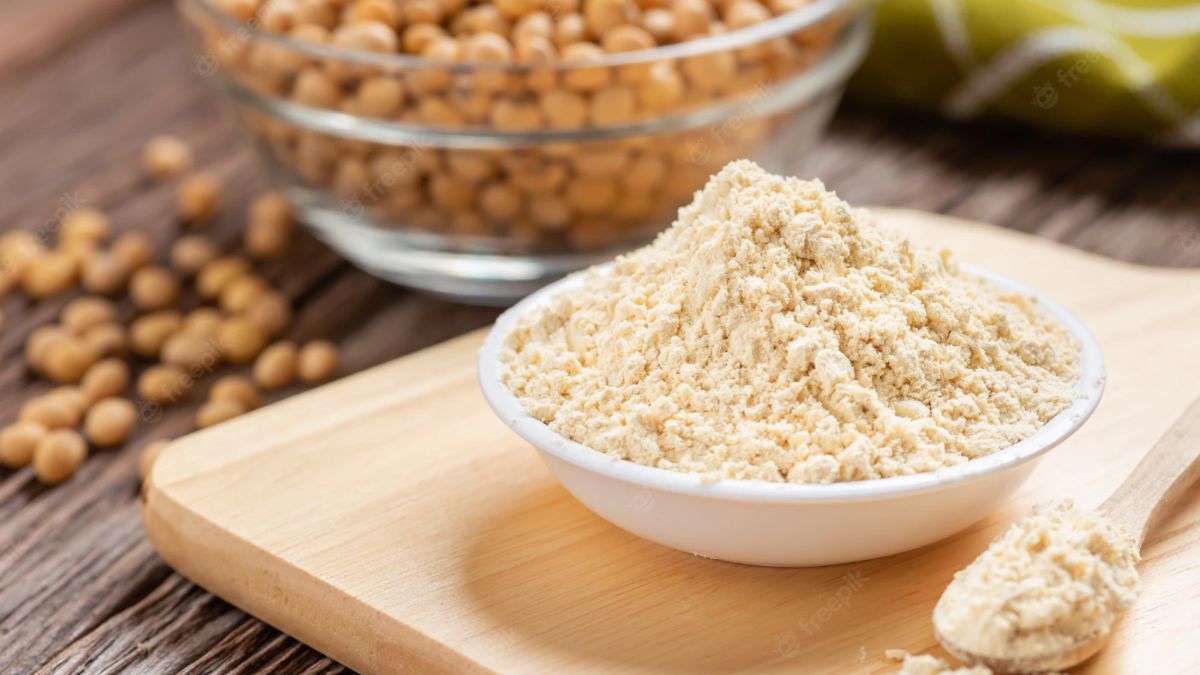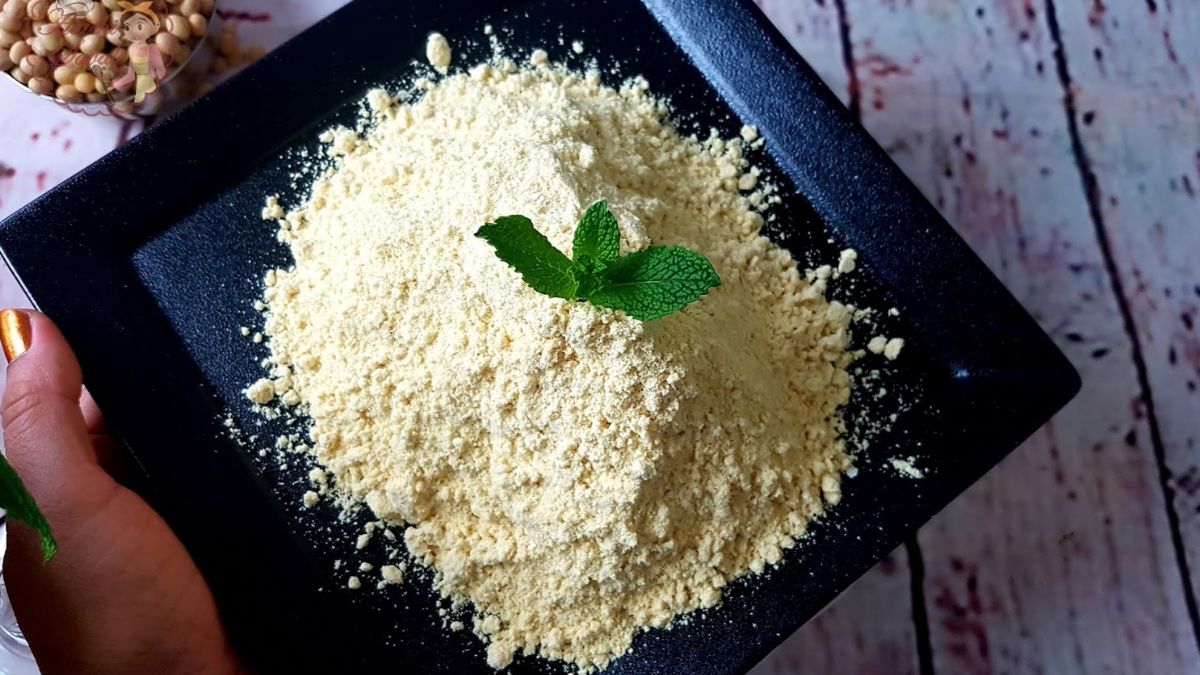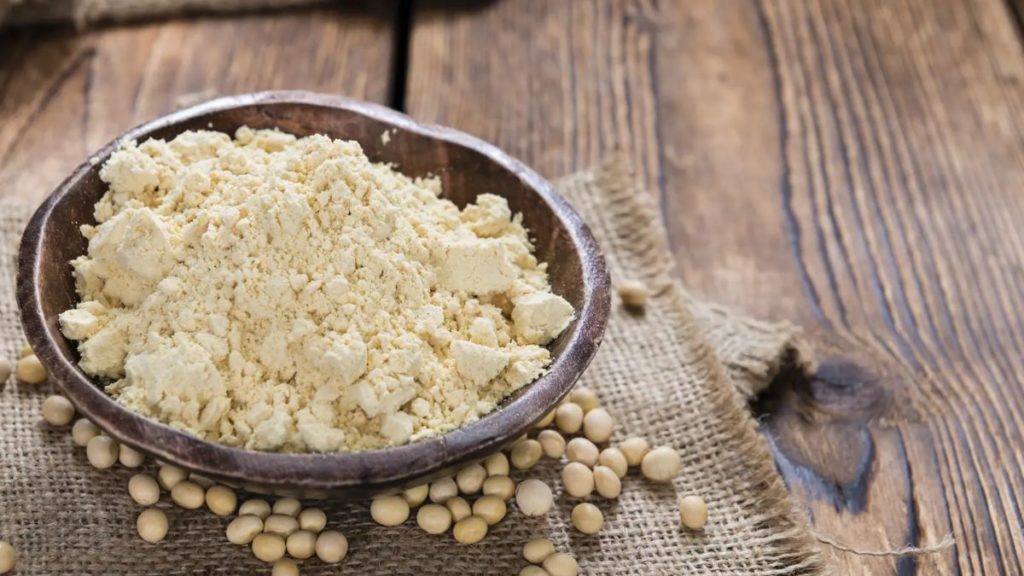Soy flours are made by grinding dehulled, full-fat soybeans or dehulled, fat-free soybean flakes into a fine powder. The flour is an alternative to wheat flour made by grinding roasted, dehulled soybeans into a fine powder. Many nutritionists think that this kind of soy is not healthy. The problem with this soy product is that it doesn’t get rid of the trypsin inhibitor, which makes the soy hard to digest. Soy flour is used to make baked goods that are sold in stores. Soy flour can be a gluten-free alternative, but we think there are better options for a healthy diet. You can get soy flour with full fat or with less fat.
What is Soy Flour?
Soy flour is a high-protein product made from ground, roasted soybeans. In addition to protein, it contains soy isoflavones, calcium, iron, and B vitamins. Its flavor ranges from mild to intense, depending on how it is processed. It can be used in place of wheat flour or whole grain flour in many recipes. There are three kinds of soy flour: natural, full-fat, low-fat, and defatted. Full-fat soy flour keeps the oils that soybeans already have, and natural soy flour has about 66 percent of low-fat soy flour’s fat. It is made from defatted soybeans, but it still has some fat.
Soy flour adds protein and nutrients to recipes and gives the finished product taste, texture, and moisture. It should be kept in airtight containers in the fridge or freezer to stay fresh and last as long as possible. Most of the time, it can be kept this way for up to a year. Soy flour tends to brown more quickly than other types of flour, which means that cooking times may need to be cut.
Keep an eye on baked goods to ensure they don’t get too done. Putting the temperature down may also help keep food from being overcooked. It is also important to stir the flour before measuring it because it tends to pack down when stored. You can make the flour taste nutty by lightly toasting it in a dry skillet before using it in a recipe.
Soy flour is usually sold in health food stores, natural food stores, the natural foods section of big supermarkets, and online. This flour is used in many ready-made foods like cakes, doughnuts, and pies because it makes the food taste better and keeps the dough from absorbing too much fat while cooking. Soy concentrate is made by taking soybeans that have already been dehulled and defatted and reducing the number of carbs and sugars they have.
This process makes a soy protein concentrate with a lot of protein and fiber. This concentrate is often used in baked goods and cereals and is a filler in meat and poultry products to add protein and improve their nutritional value. Soy protein isolate is the name of the soy product that has the most protein. Most of the fats and carbs in this product have been taken out, leaving a food that is 90% protein.
Benefits of Soy Flour
Soy flour is made by grinding roasted soybeans into a fine powder. According to SoyFoods.com, it is a good source of proteins, iron, B vitamins, and calcium, giving many foods a nice texture and taste. Soy flour can be bought with all of its natural oils or “defatted,” which means that all of the oils have been taken out of it during processing. Soy flour that has been “defatted” has a slightly higher amount of protein and calcium. Both types of soy flour are good for your health.
Reduces Menopausal Symptoms
Cardiovascular Health
Several publications show a strong epidemiological link between soy eating and a lower heart disease risk. In a recent prospective study of Chinese women, coronary events dropped by more than 50% from the lowest (4.50 g/d) to the highest (11.19 g/d) quartile of daily soy intake. People who eat a lot of soy have lower cholesterol levels. In particular, Nagata et al. found that the risk of vascular disease decreased as the Japanese population’s soy protein intake increased by quartiles. Early studies showed that strict vegetarians had lower levels of low-density lipoprotein cholesterol (LDL-C) and higher levels of high-density lipoprotein cholesterol (HDL-C) than free-living non-vegetarians of the same age and gender. In a recent study that compared vegetarian and non-vegetarian older women, the same results were found.
Antiatherosclerotic Effects
Epidemiological research shows a link between eating soy protein and a lower risk of heart disease, which supports the idea that it can help prevent atherosclerosis. Several studies on different animal models show that eating soy protein can slow the growth and size of atherosclerosis made in the lab. The anti-atherosclerosis effect of soy protein preparations has been linked to a number of their parts, such as the proteins and the isoflavones.
Kidney Disease
Soy proteins could be used in the clinic to treat hyperlipidemias caused by kidney disease, especially nephrotic syndrome. In this case, switching from an animal-based diet to a vegetarian soy-based diet greatly lowers serum cholesterol and urine protein. A recent study by Teixeira et al. found that a soy protein isolate-based diet, compared to a casein-based diet, can improve both serum lipids and nephropathy biomarkers in Type 2 diabetic patients. From long-term studies still going on, it also seems that switching to a soy-based diet may slow the progression of renal disease.
Prevention of Breast Cancer
Isoflavone has antiestrogenic effects like lowering estrogen levels and making periods last longer. It may also help lower the risk of breast cancer by stopping cancer cells from growing. Since isoflavone stops the growth of ER-positive and ER-negative breast cancer cells, these effects are either antiestrogenic or not normal. Since most of the effects are seen at concentrations above normal, more research is needed to find out what happens in more normal in vitro, in vivo, and human studies. High isoflavone concentrations in the body and the presence of estrogen and other substances may work together to lower cancer risk.
How to Select Soy Flour?
Soy flour is easy to find in grocery stores these days.
• Soy beans have something in them that makes protein hard to digest. So, it’s better to buy ready-made flour since all the things that make flour less healthy have been taken out. Also, if you want to use soy flour with wheat flour, mix ready-made soy flour with wheat flour instead of putting soy and wheat in a mill and grinding them together.
• Check the packed and use-by dates before you buy by reading the package.
Is Soy Flour Keto?
Soy Flour is not keto-friendly because it is high in carbs. It may kick you out of ketosis even with small serving size.
Too Many Carbs-
- Soy flour is not good for keto because it has a lot of net carbs (22.32g of net carbs per 100g serving).
- To stay in ketosis, you should limit your net carb intake to 20g to 30g daily. Using this keto macros calculator, you can figure out how much net carbs you should eat daily.
- You could also look for other types of flour low in net carbs.
Not an Ideal Source of Fat for Keto-
- Soy flour is not a good fat source for keto because it has a lot of carbohydrates.
- Your body will only be able to use fats for energy (ketosis) if you limit the number of net carbs you eat daily to 20g to 30g. So, it’s best to get your fats from foods high in fat but low in net carbs.
- Avocado, salmon, and ghee are good examples of foods high in fat but low in carbs.
Minimally Processed But High in Carbs-
- Soy flour hasn’t been changed much, but it’s not good for keto because it has a lot of carbs.
- To lose health on keto, you should check the macros and the ingredients of the foods you eat.
- Sweeteners, oils, and food additives are some of the most common things that need to be checked for keto.
What are the Culinary Uses of Soy Flour?
Soy flour sometimes gets caked, so it should be stirred once before measuring it for a recipe. Soy flour can be used as-is or lightly toasted before adding it to a recipe for a nice nutty taste. Put the soy flour in a dry skillet and cook it over moderate heat, stirring it so often.
Soy flour can be used to thicken gravies and sauces when it is finely ground, or it can be added to baked goods when it is finely ground. It makes fudge and other candies, pies, doughnuts, cakes and rolls, pasta, pancake mixes, and frozen desserts.
• Soy makes baked goods more tender and moist and keeps them from going stale.
• Foods made with soy flour brown more quickly, so sometimes the baking time needs to be shortened, or the temperature needs to be lowered slightly.
• You can replace up to a quarter of the flour called for in a recipe with soy flour when making things like muffins and cookies that don’t have yeast. For yeast-raised foods like bread, you can replace up to 15% of the flour in the recipe by adding two tablespoons of soy flour to each cup of flour before measuring. Since soy flour doesn’t have gluten, the protein that gives yeast-raised baked goods their shape, more than this amount will make the bread too heavy and dense. Soy flour is also a good egg substitute in baked goods. You can use one tablespoon of soy flour and one tablespoon (15 ml) of water in place of 1 egg.
• When fried foods, like doughnuts, are made with soy flour, the dough doesn’t soak up as much fat. You can also quickly make your soymilk with soy flour.
Is Soy Gluten-Free?
Soy is in many everyday foods, so if you have food allergies, it’s important to know how soy might affect them. Gluten is the name for the protein found in wheat and other grains. Gluten is fine to eat in most diets, but a small number of people have problems with it or are allergic to it. In these situations, it’s important to know what’s in your food to ensure you’re giving your body what it needs. Gluten is not in soy. Soybeans and soy protein, which comes from soybeans, do not have gluten. But that doesn’t mean that all soy products are gluten-free. We broke down a few more common things on food labels.


